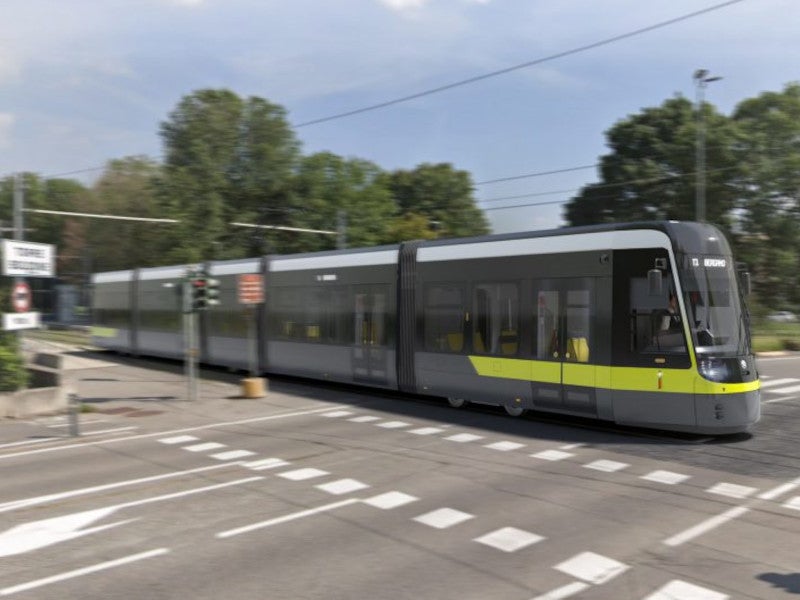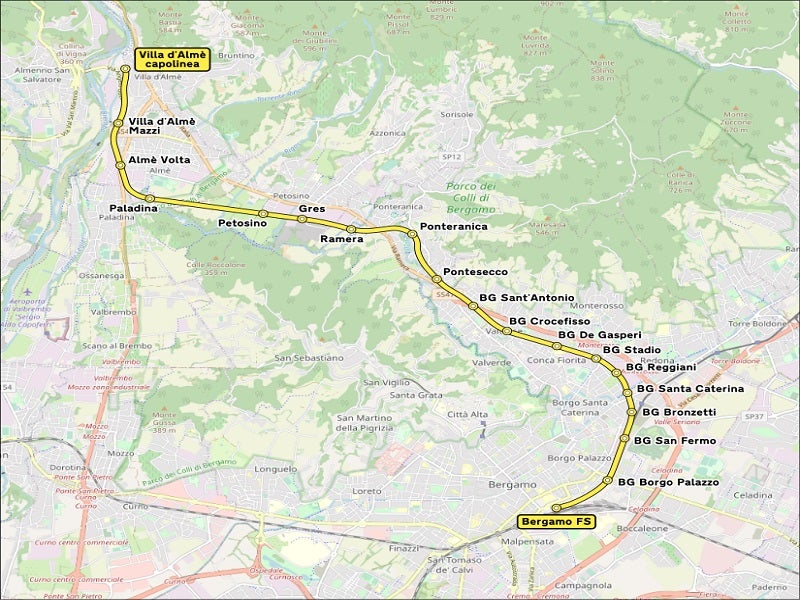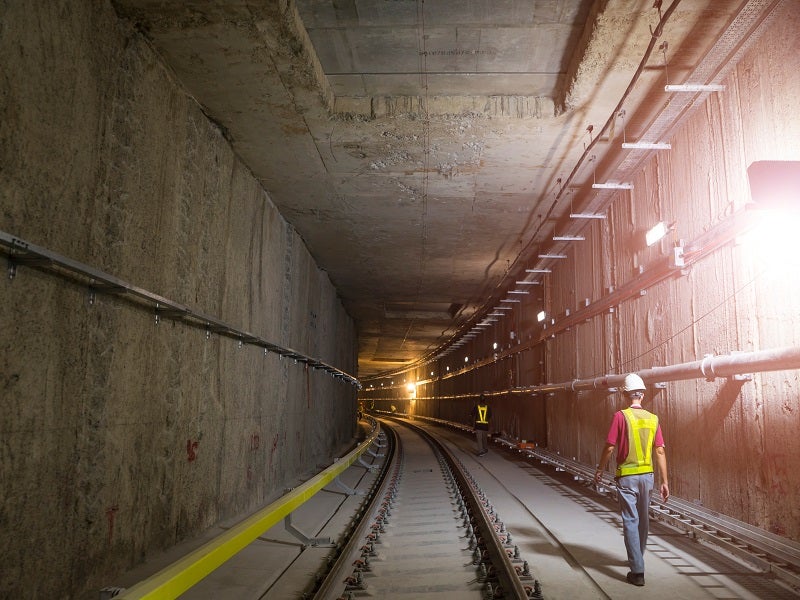The T2 tramway line is a new 11.5km line being built between Bergamo and Villa d’Alme as part of the existing Bergamo interurban tramway in Lombardy, northern Italy.
The tramway is operated by Tramvie Elettriche Bergamasche (TEB), a public transport operator.
TEB in collaboration with the Municipality of Bergamo developed the technical-economic feasibility project for the T2 Line in December 2018, following which the final design and development works commenced.
The estimated investment in the project is €225.01m ($243.8m). The project is expected to be completed in September 2026. It will have a travel time of 30 minutes between Bergamo and Villa d’Alme.
The T2 Line will complement the existing T1 Bergamo-Albino line, which connects Bergamo’s urban centre with the Seriana Valley through 16 stations, leveraging its infrastructure and equipment.
The new line will seamlessly integrate with public transport services in the urban area of Bergamo and extend to the suburban networks of the Brembana Valley and Imagna Valley, catering to 240,000 inhabitants.
It will be used by an estimated 4.5 million passengers each year and is expected to reduce car traffic by 26 million km per year.
Location details
The T2 Line will follow the route of the former Brembana Valley railway, which was decommissioned in 1966. It will pass through five municipalities: Bergamo, Ponteranica, Sorisole, Alme and Villa d’Alme.
T2 tramway line Bergamo – Villa d’Alme details
The T2 tramway line Bergamo – Villa d’Alme runs along a private, protected route featuring 23 at-grade crossings that accommodate both road traffic and pedestrians.
The entire line will operate on a double track except for a section at the Ramera tunnel in Pontesecco where it will operate on a single track.
The railway line will include a short tunnel at Pontesecco passing via Maresana, overpasses at S. Antonio/Fabriciano passing through Drossi and Ca Fornaci, and underpasses at Viale Giulio Cesare and SS. 470. It will also include three bridges, one above the Morla stream and two above the Quisa stream.
T2 tramway line station details
The T2 Line will include 17 stations, including nine in Bergamo, two each in Ponteranica, Sorisole, Alme and Villa d’Alme. It will share the central Bergamo terminus and the first two stops of the T1 Line at Borgo Palazzo and San Fermo.
The stations within Bergamo municipality include Bronzetti, Santa Caterina, Reggiani, Stadium, De Gasperi, Crucifix and S Antonio. The Bronzetti station will serve as the interchange between the two tramway lines.
The stations within the Ponteranica municipality are Pontesecco and Ponteranica, and in the Sorisole municipality are Gres and Petosino.
Paladina and Alme Volta are two stations in Alme municipality, while two more stations will be developed in the Villa d’Alme town at Villa d’Alme Mazzi and Villa d’Alme Capolinea.
The stations will be developed parallel to the tramway line and can be accessed through two pedestrian passages, located at the two ends of the stop. The stations will feature slightly sloping ramps, which will provide easy access to all users.
Infrastructure details
TEB will construct seven interchange car parks, along with a 10km long bike path adjacent to the tramway.
The bike path extending from San Fermo to Villa d’Alme will be 2.5m wide. It will integrate seamlessly with existing bike networks, enhancing cycling mobility.
The car parks will provide a total of 513 parking spaces. They will be situated close to the De Gasperi and S. Antonio, Ramera, Paladina, Alme Volta, Villa d’Alme Mazzi and Villa d’Alme.
The existing Ranica operations control centre will serve as the operational hub for both tram lines, focusing on optimising management and reducing costs.
A new depot will be constructed along the T2 Line near the Petosino stop, designed for housing, washing and maintaining the trams.
Rolling stock
Ten ForCity Classic low-floor trams developed by Skoda Transportation, a transport solutions provider, will operate on the new tramway line. The bidirectional trams, comprising five sections and three bogies, will be equipped with traction motors.
The trams will be 33m long and can accommodate up to 281 passengers. They can reach a maximum speed of 70km/h. In the densely urbanised stretch from Ponteranica to Bergamo, the speed limit will be 50km/h, decreasing to 15km/h near road crossings.
Each vehicle includes 66 seats, including 64 fixed seats and two folding seats that can be reversed to create spaces designated for wheelchairs. All seats are made from vandal-resistant, non-slip material.
Additionally, each vehicle features two designated spaces for passengers with reduced mobility. These spaces include a backrest and a belt lace system, a handrail to aid with boarding manoeuvres, and an intercom system for communication with the driver.
The tram floor is constructed with durable materials that offer better water absorption resistance, while the handrail is made from brushed stainless steel.
The trams feature an advanced anti-collision system, aimed at enhancing safety and protecting both passengers and pedestrians.
The new trams will increase the Bergamo tramway fleet to 24, including the 14 already in service on the T1 Line.
Financing
The project is funded by the Ministry of Infrastructure and Transport, the Lombardy Region, the Municipality and Province of Bergamo, along with other municipalities affected by the line, with support from the BIM Consortium, which includes 127 municipalities and four mountain communities.
The Ministry of Infrastructure and Transport is providing €151.5m ($165.5m) for the project, while the Lombardy Region will contribute €40m and the City and Province of Bergamo will provide €9.5m.
Other municipalities along the route are providing €4m ($4.3m) and the BIM Consortium is contributing €3m ($3.27m).
Contractors involved
The definitive study for the project was undertaken by a team of designers named RTI Tramsi comprising Italferr as the lead entity, supported by ETS, SDA PROJECTS and Arini.
Italferr was responsible for developing key components including depots, tunnels and structures, as well as geotechnical, geological, hydraulic, seismic and archaeological studies.
Architect Paolo Belloni provided design guidance concerning the architectural and landscape aspects of the buildings, the depot and railway stations at Bronzetti and Ponteranica.
The executive project was prepared by the RTP consortium, which included Systra-Sotecni (as the lead), SWS Engineering and Architecna Engineering.
The contract for executing the project was awarded to the RTI consortium, consisting of Impresa Milesi geom. Sergio, Generale Costruzioni Ferroviarie (GCF), Skoda Transportation and Impresa Edile Stradale Artifoni.
The consortium is responsible for overseeing executive design, safety coordination, executing the construction works, and supplying tramway vehicles and equipment.
Skoda will deliver ten bidirectional trams for the new line, along with a full-service commitment spanning three years.
GCF will supervise the construction of the track works, electrical traction systems, planned electrical substations, signalling infrastructure and all aspects of plant engineering for the project.






